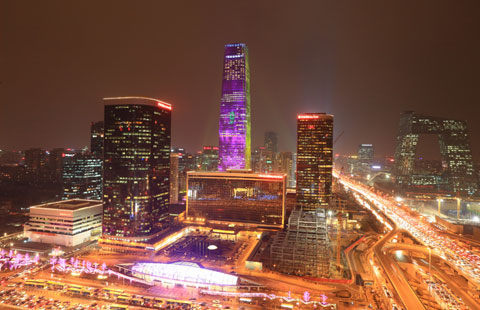
While news events and cultural issues can be stumbling blocks, there are reasons to believe more Chinese will visit this year
Tourism was on the table in December when South African President Jacob Zuma visited China, South Africa's biggest trading partner in terms of both imports and exports.
One of the topics of meetings with President Xi Jinping and other leaders was a discussion on ways to support tourism promotion conducted by South Africa and China, according to South African Minister of International Relations and Cooperation Maite Nkoana-Mashabane, who spoke at a news briefing in Pretoria.
China hosted the Year of South Africa 2014, which provided an opportunity to promote the country as a destination for Chinese outbound tourists.
Nkoana-Mashabane said South Africa would host the 2015 Year of China in South Africa.
South Africa also would host the next Forum on China-Africa Cooperation, which will be co-chaired by both countries in 2015.
FOCAC started in 2000 in Beijing when the Chinese government assembled more leaders from the African continent in one place than had ever met in Africa itself.
Two more summits have been held in Beijing, in 2006 and 2012, and two summits in Ethiopia and Egypt in 2003 and 2009. Each of these summits had tourism-related discussions on the agenda, with the attention shifting more and more toward Chinese investment in tourism infrastructure in Africa, an important region for China's outward direct investment.
Other activities in the continent also have spotlighted the industry, such as the Tourism Stakeholders Forum on China's Outbound Market, held by the China-Ghana Friendship Association in June 2014.
Souvenir sellers in the main African tourism destinations have learned to say ni hao (hello) and pianyi (cheap) to attract Chinese customers. However, the number of Chinese tourists visiting these destinations is still relatively low. For example, Kenya did not exceed 37,000 Chinese visitors in 2013, a far cry from the 1.3 million Chinese that Kenyan President Uhuru Kenyatta proclaimed as the Kenyan tourism industry's goal when he visited China that year.
In September 2014, the Kenyan government signed a memorandum of understanding with China on promotion, security and transport in the tourism sector. Based on the agreement and the announcement of a $2.3 million budget to spend on tourism recovery, the post-Ebola target number of Chinese tourists visiting Kenya has now been lowered to a still rather hopeful 1 million arrivals per year.
By comparison, Egypt's hopes for the Chinese market are more moderate. Although the tourism industry was hit hard by domestic instability over the past three years, the government in Egypt is expecting a recovery in its tourism sector this year. The Egyptian government supports plans to launch direct flights from four airports in China to Aswan, targeting 142,000 Chinese tourist arrivals in Egypt in 2015.
For South Africa, however, China has already developed into the fourth-largest source market for tourist arrivals, growing by 15 percent in 2013 to reach almost 152,000 arrivals.
Because of the outbreak of Ebola in West Africa, the number of travelers from China to African countries fell in 2014. That was the case even though the epidemic was confined to several countries in West Africa, and Nairobi's distance from the epidemic is so great that Frankfurt or London are actually closer to the Ebola-stricken nations of Liberia and Sierra Leone than Nairobi is.
The number of Chinese tourists to Zimbabwe in the first six months of 2014 dropped to 2,730 from about 10,000 in the same period the previous year. In order to entice Chinese travelers to come back in bigger numbers, the Zimbabwean and Chinese governments agreed in November 2014 on a visa-on-arrival policy for Chinese tourists.
In Kenya, tour operators reported at least a 30 percent drop in Chinese arrivals in the past half year or so.
Margaret Wambui, managing director of Binti Safaris in Kenya, says she sees enthusiasm for Chinese tourists lacking in most African countries.
She notes that traditional travelers to Africa are usually Europeans and Americans who speak English. Because of the long colonial association with many of those visitors' countries, they can be expected to know a lot about their shared history and bring with them some knowledge about the beauty of the African landscape and its heritage when they visit.
But many hoteliers and tour operators are a bit apprehensive about Chinese travelers because of factors such as language barriers and cultural differences.
According to Wambui, the tourist boards in most African countries are trying to attract Chinese visitors, but often use traditional methods, relying for example more on road shows than on social media marketing. The money put into marketing to Chinese tourists is also significantly less compared with marketing to Europeans and Americans in most cases.
As in other destinations, the market is segmenting rapidly. Typical package tours are sold for around 10,000 yuan ($1,609), but luxury tours start at around 40,000 yuan.
With the marketing efforts of both private and public sector stakeholders in African destinations increasing and the Ebola scare hopefully subsiding, most African countries can expect growing arrival numbers in 2015.
Until recently, Chinese tourists mostly went to places in Africa they previously heard about, namely Egypt, Kenya and South Africa, but also increasingly to islands like Seychelles and Mauritius. Other countries for the most part have had only business visitors or Chinese managers and workers showing up in their statistics. In most cases, these countries also possess major tourism draws, but most Chinese have not been made aware of them. With more marketing, easing visa restrictions, China-specific services being offered and the eventual establishment of direct air connections from China to countries such as Tanzania, this should change in 2015.
The English-speaking areas in eastern and southern Africa will continue to see more Chinese arrivals than western African countries, which are not only farther away and largely French-speaking, but also will have more problems getting rid of the shadow of Ebola. So in 2015, improving the perception of Africa as a safe destination will still be the most important task for government and private tourism stakeholders.
As Wambui says: "The last couple of years have been a learning curve for Africa. I see many African countries, tourist boards, hoteliers and tour operators putting their best foot forward in 2015, to swiftly attract more Chinese tourists."
The author is director of the China Outbound Tourism Research Institute in Hamburg, Germany. The views do not necessarily reflect those of China Daily.
|
Li Min / China Daily |
(China Daily Africa Weekly 01/02/2015 page7)








